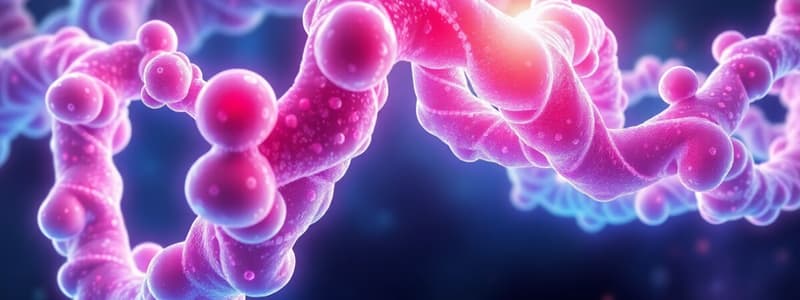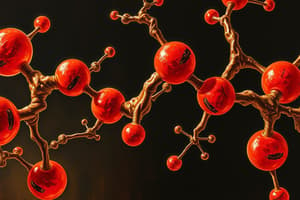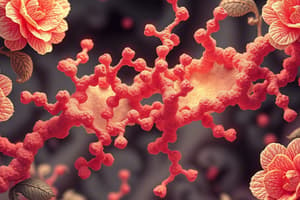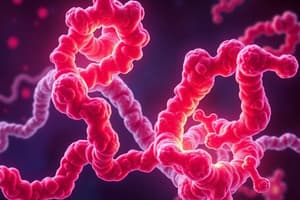Podcast
Questions and Answers
What is the most common type of hemoglobin found in adults?
What is the most common type of hemoglobin found in adults?
Hemoglobin A
What is the function of myoglobin?
What is the function of myoglobin?
Myoglobin is found in skeletal muscles and heart and serves as an oxygen storage protein.
What is the effect of increasing levels of 2,3-Bisphosphoglycerate (2,3 BPG) on oxygen affinity of hemoglobin?
What is the effect of increasing levels of 2,3-Bisphosphoglycerate (2,3 BPG) on oxygen affinity of hemoglobin?
- No effect on oxygen affinity
- Increases oxygen affinity
- Decreases oxygen affinity (correct)
Which of these is a classic clinical manifestation of sickle cell anemia?
Which of these is a classic clinical manifestation of sickle cell anemia?
Which type of thalassemia is characterized by a decreased or absent production of beta globin chains?
Which type of thalassemia is characterized by a decreased or absent production of beta globin chains?
What is the name of the genetic disorder that causes sickle cell anemia?
What is the name of the genetic disorder that causes sickle cell anemia?
Which of the following conditions can be a consequence of severe anemia in beta thalassemia major?
Which of the following conditions can be a consequence of severe anemia in beta thalassemia major?
Carbon monoxide binds to iron in heme with an affinity 240 times greater than oxygen.
Carbon monoxide binds to iron in heme with an affinity 240 times greater than oxygen.
What is the name of the condition caused by an excess of methemoglobin?
What is the name of the condition caused by an excess of methemoglobin?
What is the treatment for methemoglobinemia?
What is the treatment for methemoglobinemia?
What is the primary reason sickle trait is protective against Plasmodium falciparum malaria?
What is the primary reason sickle trait is protective against Plasmodium falciparum malaria?
What is the name of the condition in which red blood cells form crescents?
What is the name of the condition in which red blood cells form crescents?
Which of the following is NOT a common symptom of sickle cell disease?
Which of the following is NOT a common symptom of sickle cell disease?
What is the name of the condition that occurs when sickled red blood cells block small blood vessels?
What is the name of the condition that occurs when sickled red blood cells block small blood vessels?
What is the term for the condition where the spleen, due to repeated infarctions, no longer functions effectively?
What is the term for the condition where the spleen, due to repeated infarctions, no longer functions effectively?
What is the name of the drug that can help increase the amount of fetal hemoglobin (HbF) in patients with sickle cell disease?
What is the name of the drug that can help increase the amount of fetal hemoglobin (HbF) in patients with sickle cell disease?
What is the name of the rare type of hemoglobin that is caused by a mutation in the beta globin gene, replacing glutamic acid with lysine?
What is the name of the rare type of hemoglobin that is caused by a mutation in the beta globin gene, replacing glutamic acid with lysine?
Sickle cell trait does not protect against infection with Plasmodium falciparum malaria.
Sickle cell trait does not protect against infection with Plasmodium falciparum malaria.
Which of the following genetic alterations is responsible for the development of sickle cell disease?
Which of the following genetic alterations is responsible for the development of sickle cell disease?
Flashcards
Globular Proteins
Globular Proteins
Proteins that are water-soluble and spherical in shape.
Myoglobin
Myoglobin
A globular protein that binds oxygen in muscle tissue.
Hemoglobin
Hemoglobin
A globular protein in red blood cells that carries oxygen.
Bohr Effect
Bohr Effect
Signup and view all the flashcards
Oxygen-Dissociation Curve
Oxygen-Dissociation Curve
Signup and view all the flashcards
Hemoglobinopathies
Hemoglobinopathies
Signup and view all the flashcards
HbS
HbS
Signup and view all the flashcards
HbC
HbC
Signup and view all the flashcards
HbSC
HbSC
Signup and view all the flashcards
Alpha Thalassemia
Alpha Thalassemia
Signup and view all the flashcards
Beta Thalassemia
Beta Thalassemia
Signup and view all the flashcards
Haldane Effect
Haldane Effect
Signup and view all the flashcards
O2-Hb Dissociation Shift
O2-Hb Dissociation Shift
Signup and view all the flashcards
CO2 Affinity
CO2 Affinity
Signup and view all the flashcards
Pulmonary Arteries
Pulmonary Arteries
Signup and view all the flashcards
Alveoli
Alveoli
Signup and view all the flashcards
Deoxygenated Hemoglobin
Deoxygenated Hemoglobin
Signup and view all the flashcards
Oxygenated Hemoglobin
Oxygenated Hemoglobin
Signup and view all the flashcards
Shift Left
Shift Left
Signup and view all the flashcards
Study Notes
Biochemistry 8
- Globular proteins, hemoglobin and myoglobin structure and function
- Bohr effect
- Hemoglobinopathies
Topics to be Learned
- Globular hemeproteins
- Myoglobin structure and function
- Hemoglobin structure and function
- Oxygen-dissociation curve and Bohr effect
- Hemoglobinopathies (HbS, HbC, HbSC, alpha and beta thalassemias)
- Topics cover pages 58-89 of the 8th edition of Lippincott Illustrated Reviews Biochemistry Textbook.
Hemoglobin
- Globin chains: Alpha (α), Beta (β), Gamma (γ), Delta (δ)
- 4 chains in 2 pairs
- Heme: Non-peptide molecule containing iron (Fe) and a porphyrin ring
- Oxygen binds iron
Hemoglobin Types
- Hemoglobin A (HbA): α2β2 (95%)
- Hemoglobin A2 (HbA2): α2δ2 (2-3%)
- Hemoglobin F (HbF): α2γ2 (Fetal type)
Oxygen-Hgb Dissociation Curves
- Y-axis: Percentage of hemoglobin bound to oxygen
- X-axis: Partial pressure of oxygen (pO2)
Oxygen-Hgb Binding
- Cooperative binding: Binding of one O2 molecule increases affinity for subsequent molecules
- Positive cooperativity: Affinity for the last O2 molecule is 300 times greater than the affinity for the first molecule
- S-shaped curve
Allosteric Proteins
- Allosteric site: "Other site" for binding, influencing binding at another site
- Multi-subunit proteins
- Hemoglobin is an allosteric protein
- Positive allosteric effect: O2 cooperativity
Hemoglobin Forms
- Taut form (T): Releases O2, favored in tissues
- Relaxed form (R): Holds onto O2, favored in lungs
Peripheral Tissue (Bohr Effect)
- COs are generated in tissues
- CO2 + H2O ↔ H2CO3 ↔ HCO3– + H+
- Oxygen delivery to tissues
- Release of oxygen to tissues
- Chloride shift (HCO3– enters the red blood cell in exchange for Cl- ions)
O2 Affinity of Hb
- Inversely proportional to CO2 and H+ concentrations
- High CO2 and H+ lead to lower O2 affinity.
Haldane Effect
- Increased CO2 unloading in the lungs and increased O2 uptake.
- Oxygenated hemoglobin has lower affinity for CO2 than deoxygenated hemoglobin
- Shift to the left O2-Hb dissociation curve
Shifts in O2-Hgb Curves
- Hemoglobin's O2 affinity changes (not fixed)
- Environment within red blood cells alters
- Dissociation curves can shift to right or left
Right Curve Shifts (Release O2)
- Favors taut form
- Causes: Rising metabolic activity (↑CO2), decrease in pH (↓pH), increase in temperature (↑Temp). Increases P50
Left Curve Shifts (Latch on to O2)
- Favors relaxed form
- Causes: Lower metabolic activity (↓CO2), increase in pH (↑pH), decrease in temperature (↓Temp).
2,3-Bisphosphoglycerate (2,3-BPG)
- Found in red blood cells (RBCs)
- Promotes O2 release from hemoglobin
- Negative allosteric effector; increasing levels decrease Hb affinity for O2, increase O2 delivery to tissues
- Produced from diverted 1,3 BPG from glycolysis
- Increased levels are associated with high altitude, COPD and chronic anemia.
Fetal Hemoglobin (HbF)
- Predominant hemoglobin in the fetus, up to 90%
- Higher oxygen affinity than adult hemoglobin (HbA). Necessary because fetal pO2 = 40 mmHg.
- Left shift due to altered 2,3-BPG binding. 2,3-BPG binds poorly to gamma chains, increasing oxygen affinity.
Myoglobin
- Found in skeletal muscle and heart
- Single polypeptide chain
- High O2 affinity at all pressures
- First binds oxygen
Carbon Monoxide (CO)
- Binds to iron in heme 240x more strongly than O2
- Forms carboxyhemoglobin (HbCO), blocking O2 binding sites
- Lower O2 carrying capacity = functional anemia
- Left shift in oxyhemoglobin dissociation curve.
Carbon Monoxide Poisoning
- Nonspecific symptoms (headache, malaise)
- Classic symptom (cherry-red lips)
- Diagnosis involves carboxyhemoglobin level
- Treatment: oxygen
Methemoglobinemia
- Small amount of iron in hemoglobin is oxidized from Fe2+ to Fe3+
- Fe3+ (methemoglobin) cannot bind O2
- Excess methemoglobin leads to hypoxia
- Acquired from drugs (local anesthetics, nitric oxide, dapsone)
- Treatment: methylene blue (reducing agent to convert Fe3+ to Fe2+)
Clinical Scenario
- Describes conditions associated with reduced O2 saturation or anemia
Thalassemia
- Decreased or absent production of globin chains
- Alpha thalassemia: reduced α-globin production
- Beta thalassemia: reduced β-globin production
HbH Disease
- Very little α-globin production
- Excess β-globin
- HbH forms: 4 β-chains
- Easily damaged; much lower affinity for O2 than HbA
- Associated with hypochromica, microcytic anemia leading to symptoms such as abnormal red blood cells' deformability, extravascular hemolysis, and elevated LDH.
Hgb Barts
- No α-globin production
- Four γ-globin chains, causes severe fetal hemoglobinopathy.
- Very high affinity for oxygen.
Beta Thalassemia
- Reduced β-globin synthesis
- Beta Thalassemia Minor: Asymptomatic/mild anemia, detectable in routine blood work
- Beta Thalassemia Major (Cooley's anemia): severe, chronic anemia leading to bone abnormalities
Target Cells
- Due to increased surface area to volume ratio.
Extra-medullary hematopoiesis
- Hematopoiesis outside the bone marrow
- Often produces nucleated RBCs.
Parvovirus B19
- Infection can cause aplastic crises
- Critically affects beta thalassemia major patients who depend on bone marrow for RBC production.
Sickle Cell Anemia
- Autosomal recessive disorder
- Abnormal β-globin chains (HbS)
- Makes up 95% of Hb
- Single base substitution (adenine→thymine) in the sixth codon of β-globin gene.
- Substitution of valine for glutamate in beta chains (valine is non-polar hydrophobic)
- Deoxygenated HbS is poorly soluble, leading to sickling, polymerization and damage that leads to RBC deformability, extravascular hemolysis, and elevated LDH.
- Leads to several complications:
- Vaso-occlusion (may affect many organs, causing painful crises)
- Increased risk of infections
- Splenic failure
- Increased HbF for treatment
- Treatment: Hydroxyurea (increase HbF) Transfusion therapies Bone marrow transplant (potential cure)
- Leads to several complications:
- Vaso-occlusion (may affect many organs, causing painful crises)
Sickle Cell Trait
- One mutated beta globin gene
- Normal beta gene is more effective
-
50% HbS necessary for sickling
Sickle Cell Diagnosis
- Electrophoresis (showing HbS presence), special testing (sodium metabisulphite causing HbS precipitation), sickling testing: detects HbS by observing its insolubility in this specific environment.
Malaria
- Sickle cell trait provides protective effect against plasmodium falciparum, as cells sickle when infected, promoting faster clearance.
- Does not eliminate malaria entirely
- Effective in certain parts of Africa.
HbC
- Rare genetic mutation.
- Different from sickle cell anemia.
- Glutamic acid replaced by lysine.
- Heterozygotes have mild anemia; extravascular hemolysis.
- Presence of HbC crystals is detectable in blood smears. Induces red blood cell dehydration, increasing MCHC.
Studying That Suits You
Use AI to generate personalized quizzes and flashcards to suit your learning preferences.




